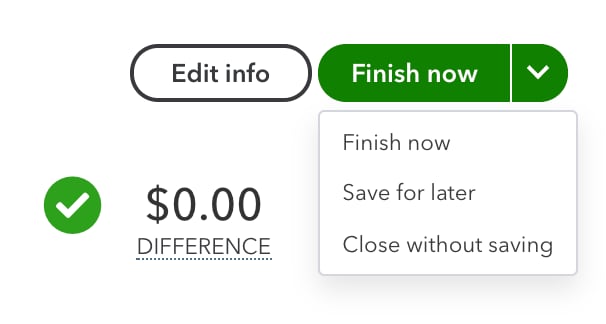Reconcile an account in QuickBooks Online
by Intuit•2927• Updated 1 week ago
Learn how to reconcile your accounts so they always match your bank and credit card statements.
Just like balancing your checkbook, you need to review your accounts in QuickBooks to make sure they match your bank and credit card statements. This process is called reconciling.
When you have your bank statement in hand, you'll compare each transaction with the ones entered into QuickBooks. If everything matches, you know your accounts are balanced and accurate. We recommend reconciling your checking, savings, and credit card accounts every month. Here's how to get started. Or, check out our complete reconciliation guide.
For a better experience, open this article in QuickBooks Online. Launch side-by-side view
Get personalized help using QuickBooks with QuickBooks Live.
To watch more how-to videos, visit our video section.
Step 1: Review your opening balance
If you're reconciling an account for the first time, review the opening balance. It needs to match the balance of your real-life bank account for the day you decided to start tracking transactions in QuickBooks.
Tip: You can save a step by connecting your bank and credit cards to online banking, which automatically downloads transactions and enters the opening balance for you.
If you forgot to enter an opening balance in QuickBooks in the past, don't worry. Here's how to enter an opening balance later on.
Note: Entering a service charge and interest-earned options are only available when the bank account isn't connected to online banking.
Need more info? Learn more about opening balances.
Step 2: Start a reconciliation
Once you have your monthly bank or credit card statement, you can start reconciling. If you're reconciling multiple months, do them one statement at a time, starting with your oldest statement:
- If your accounts are connected to online banking, make sure you match and categorize all of your downloaded transactions.
- Go to Settings
 and then Reconcile (Take me there). If you're reconciling for the very first time, select Get started.
and then Reconcile (Take me there). If you're reconciling for the very first time, select Get started. - From the Account ▼ dropdown, select the account you want to reconcile. Make sure it's the same one on your statement.
Important: If you see a message about a previous reconciliation, select We can help you fix it. You need to fix this before you start. - Review the Beginning balance. Make sure the beginning balance in QuickBooks matches the one on your statement. Here's what to do if they don't match.
- Enter the Ending balance and Ending date on your statement. Some banks call the ending balance a "new balance" or a "closing balance."
- If you see it, review the Last statement ending date. This is the end date of your last reconciliation. Your current bank statement should start the day after.
- When you're ready to start, select Start reconciling.
Step 3: Compare your statement with QuickBooks
Now, simply compare the transactions on your statement with what's in QuickBooks. Go over them one-by-one. The tricky part is making sure you have the right dates and transactions in QuickBooks so you know everything matches.
Follow the section for the type of account you're reconciling:
Next steps: Review past reconciliations
Run a reconciliation report to review your work:
- Go to Settings ⚙, then Reconcile (Take me there).
- Select History by account.
- Use the dropdown menus to select the account and date range. Or print or export your reconciliation reports if you need to share them.
Edit completed reconciliations
You can make changes to past reconciliations, but be careful. Changes can unbalance your accounts and other reconciliations. It also affects the beginning balance of your next reconciliation.
Start by reviewing a previous reconciliation report. If you reconciled a transaction by mistake, here's how to unreconcile it. If you adjusted a reconciliation by mistake or need to start over, reach out to your accountant.
Sign in now for personalized help
See articles customized for your product and join our large community of QuickBooks users.
More like this
- Fix issues for accounts you've reconciled in the past in QuickBooks Onlineby QuickBooks
- Reconcile transactions that are older than your opening balance in QuickBooks Onlineby QuickBooks
- Fix issues the first time you reconcile an account in QuickBooks Onlineby QuickBooks
- About bank or credit card subaccount setupby QuickBooks

